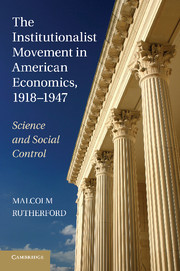Book contents
- Frontmatter
- Contents
- List of Tables
- Acknowledgments
- PART ONE INTRODUCTION
- PART TWO INSTITUTIONALIST CAREERS
- PART THREE CENTERS OF INSTITUTIONAL ECONOMICS
- 5 Institutionalism at Chicago and Beyond
- 6 Amherst and the Brookings Graduate School
- 7 Wisconsin Institutionalism
- 8 Institutional Economics at Columbia University
- 9 The NBER and the Foundations
- PART FOUR CHALLENGES AND CHANGES
- PART FIVE CONCLUSION
- Archive Collections Consulted
- References
- Index
- Titles in the series
8 - Institutional Economics at Columbia University
Published online by Cambridge University Press: 03 May 2011
- Frontmatter
- Contents
- List of Tables
- Acknowledgments
- PART ONE INTRODUCTION
- PART TWO INSTITUTIONALIST CAREERS
- PART THREE CENTERS OF INSTITUTIONAL ECONOMICS
- 5 Institutionalism at Chicago and Beyond
- 6 Amherst and the Brookings Graduate School
- 7 Wisconsin Institutionalism
- 8 Institutional Economics at Columbia University
- 9 The NBER and the Foundations
- PART FOUR CHALLENGES AND CHANGES
- PART FIVE CONCLUSION
- Archive Collections Consulted
- References
- Index
- Titles in the series
Summary
Apart from Wisconsin, the leading center for institutional economics between the wars was Columbia University. In general intellectual terms, Columbia at least equaled Chicago and Harvard, and New York was the preeminent center of American intellectual life. Moreover, in terms of the numbers of doctoral students in economics, Columbia was the leader, and by quite a margin (Froman 1942). Between 1913 and the early 1930s, Columbia became the academic home of a particularly large concentration of economists of institutionalist leaning. These included Wesley Mitchell, J. M. Clark, F. C. Mills, Paul Brissenden, James Bonbright, Robert Hale, Joseph Dorfman, Carter Goodrich, Rexford Tugwell, Gardiner Means, Leo Wolman, Horace Taylor, A. F. Burns, and, later on, Karl Polanyi. A. R. Burns and Eveline Burns should also be included as being, at the least, sympathetic to institutionalist ideas. Furthermore, over the period in question, the Department of Economics was a graduate department offering degrees within the Faculty of Political Science. The Faculty also contained the graduate departments of Sociology, History, and Public Law. The Law School contained a large contingent of members of the realist school, including, at various times, W. W. Cook, Karl Llewellyn, Underhill Moore, and Herman Oliphant. A. A. Berle was also a member of the Department of Public Law and the Law School. Robert Hale moved from Economics to the Law School, and Gardiner Means was a member of the economic research staff of the Law School between 1927 and 1933, and was an associate in law from 1933 to 1935.
- Type
- Chapter
- Information
- The Institutionalist Movement in American Economics, 1918–1947Science and Social Control, pp. 223 - 256Publisher: Cambridge University PressPrint publication year: 2011
- 1
- Cited by

